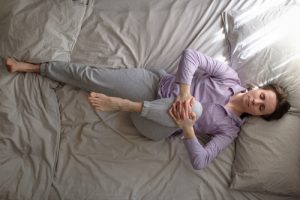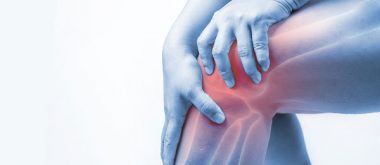If you find yourself waking up in feeling achy and struggling to move in the morning, it’s easy to chalk it up to the joke that you’re getting older, but believe it or not there is a very natural reason for these common morning aches and pains and efforts you can do to feel more comfortable morning.
Little modifications such as adjusting your sleeping posture, liquid consumption, and morning habits can all help you get ahead and ease morning pain before it settles into your body and delays your morning routine.
The Chemical Impact on Morning Pain
If you are waking up in pain and feeling that you are too young and healthy for these aches, believe it or not, you are not alone. In fact, many men and women find that when they wake up first thing in the morning they feel achy, and in some cases feel like they can hardly move, but after a few hours being awake and moving around, they start to feel better and those aches and pains start to dissipate, and there is an anatomical reason this occurs.
As you sleep and begin to wake up, several things take place on a chemical level in your body. As we sleep, chemicals that make up inflammation creates excess fluid buildup, which puts pressure on various areas, this pressure pushes and triggers mechanoreceptors (part of the sensory nervous system) and ultimately causes the feeling of pain. Once we wake up and begin moving around, causing the blood to begin flowing stronger in our body, it helps removes the chemicals that make up this inflammation.
 Another thing that occurs as we sleep or remain sedentary for extended lengths of time deals with receptors called chemoreceptors. These receptors pick up on the presence of certain nociception chemicals (a.k.a. pain causing chemicals) which increase in our system as we sit still, sleep, and are sedentary. When we are sedentary and the concentration of these nociception chemicals is high, the chemoreceptors fire and we feel pain until the blood can power through and flush them out when we are moving again. This is why those who have a more sedentary lifestyle often experience more aches and pains than those individuals who participate in regular movement and exercise.
Another thing that occurs as we sleep or remain sedentary for extended lengths of time deals with receptors called chemoreceptors. These receptors pick up on the presence of certain nociception chemicals (a.k.a. pain causing chemicals) which increase in our system as we sit still, sleep, and are sedentary. When we are sedentary and the concentration of these nociception chemicals is high, the chemoreceptors fire and we feel pain until the blood can power through and flush them out when we are moving again. This is why those who have a more sedentary lifestyle often experience more aches and pains than those individuals who participate in regular movement and exercise.
The Importance of Movement and Hydration
Because these chemical reactions take place while we remain stationary, it is important to move around to get blood flow circulating strongly first thing in the morning. When we get up and move, the blood flows stronger and carries nutrients (oxygen, electrolytes, hydrations, etc.) to the body’s cells and by doing so, flushes and removes these excess chemicals and metabolic waste, which is then filtered through the cleansing organs of the body; i.e. the kidneys, liver and gut.
To properly cleanse the body of these chemicals and waste, these organs need water and, in the case of your gut, fiber (thus the importance of a healthy diet). Your chemoreceptors respond to the molecules in your blood and have some control over the actions of your body, especially when it comes to flushing nociception chemicals. Which is where water comes into play.
Chances are, you’ve heard the suggestion that you should drink a glass of water immediately upon waking up, while there’s many benefits to this habit, one example comes into play when discussing these chemicals and your body’s morning pain cycles. For example, if you are reducing the amount of liquid you are drinking in the evening, to lessen the number of times you need to get up in the night, your chemoreceptors may choose to hold onto the toxins and chemicals that trigger pain. Because the body needs liquid to maintain a steady heartbeat, blood flow and bodily functions through the night and sedentary timespans, by reducing your fluid intake, your toxin load may stay at higher levels and increase the aches and pains you feel in the morning.
While morning aches and pains may seem unavoidable, it is possible to lessen your morning discomfort. If you find that you are still waking up sore and struggle to move, even after downing a glass of water, consider including some morning stretches or yoga before you get out of bed to help get blood circulation flowing stronger.
4 Easy In-Bed Stretches to Start Off Your Morning

Lying on your back extend both legs. Stretch your arms out to a T-position, slowly lengthen your neck, pushing your shoulders away from your ears and pointing your toes toward the foot of your bed. Slowly roll your torso and arms up toward the ceiling, bringing your arms over your head and down toward the bed behind you.
From the now seated position, transition onto your hands and knees. You can keep your knees together, directly below your hip joints, or bring them wider if it is more comfortable. Once you feel balanced, take a slow deep breath in then slowly exhale as you lower your hips toward your heels. As you pull your hips back, stretch your hands up above your head with your forehead lowering to the mattress. You can rock the crown of your head back and forth on the mattress if it feels good during this pose, and breathe slowly and deeply for as many breathes as you’d like.
Transitioning from child’s pose, return to all fours. From this table top position, exhale and tuck the tail bone under your hips while rounding the spine toward the ceiling and let your head drop down. While here, you should be pressing the palms of your hands into the mattress and dropping your shoulders away from your ears, while reaching your middle and upper back up towards the ceiling. Release the pose and inhale as you return to the starting table top position. When you’re ready, on an inhale, reach your tailbone and head up towards the ceiling, arching the spine and letting your belly drop down toward the mattress. While here spread your fingers wide apart and press your palms into the mattress while dropping your shoulders down from your ears and reaching the crown of your head up towards the ceiling. When done, return to the table top position and then rolling into a seated position to you can get up and get your day started.
While this is an example of a full body stretch you can do without ever leaving your bed in the morning it is important to consider your limitations and especially when moving for the first time after waking, to not over-stretch and be aware of your body’s movements as any stretches should be done within the range of your ability and without straining.
Considerations with Sleep Hygiene
While it may sound like we are referring to laundering practices, sleep hygiene refers to more than clean sheets. Sleep hygiene, pillow placement, and mattress choice can all have a big impact on your morning pain level.
As we age, we lose muscle mass. The mattress that worked well for you for years may suddenly be far too firm for your back, knees, and shoulders. Pay attention to how long it takes you to find a comfortable position. If you have to do a lot of squirming, consider adding a cushioned topper or getting a new mattress for more comfort and a more restful sleep.
If your bed is uncomfortable for you at this point in your life, chances are your mechanoreceptors, which are found inside your joint tissues, muscles and skin, may be triggered while you are trying to sleep. If a joint is impinged or overextended while you are trying to sleep, you may get a pain response that triggers movement, which can interrupt your sleep.
Pay Attention to Your Schedule
Believe it or not, your daily schedule can also have huge impact on your morning pain levels. If you tend to limit your sleep or are woken by morning pain, schedule time for a nap later in the day and try to sleep in a recliner, a different bed, or in a different sleeping position, such as on your back instead of on your side. Changing up your nap location may give you the chance to fall more quickly into deep sleep.
For those who struggle with chronic pain, getting to bed at the same time to each night will train your brain to fall into sleep more efficiently so you can spend more time in recovery sleep stages than thinking about your to-do list for tomorrow.
For many men and women, waking up first thing in the morning is unceasingly associated aches and pains, but with proper movements, hydration and sleep patterns those sunrise aches and pains just may start to go away, letting you start your day feeling total wellness.





